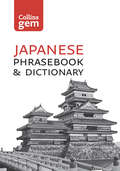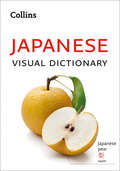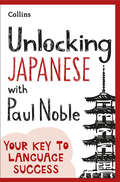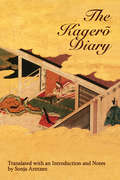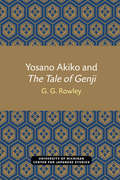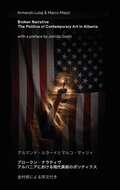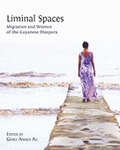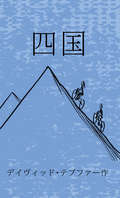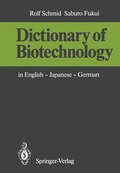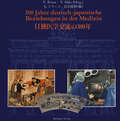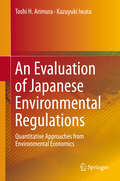- Table View
- List View
Collins Japanese Dictionary and Phrasebook Gem Edition: Essential Phrases And Words In Mini Travel Format (Collins Gem #03)
by Collins DictionariesYou will never be lost for words in your travels around Japan again! Your ideal travel companion will ensure that you can say what you need in Japanese with ease and confidence.
Collins Japanese Visual Dictionary (Collins Visual Dictionaries Ser.)
by Collins DictionariesA photographic guide to the key words and phrases in Japanese. This attractive ebook is a perfect travel companion and provides a practical guide to Japan and Japanese language and culture.
Unlocking Japanese with Paul Noble
by Paul NobleEver tried to learn Japanese and found it too hard? Bestselling language coach Paul Noble has a quick and easy way to get you back on track with his unique tried-and-tested method.
The Kagero Diary: A Woman’s Autobiographical Text from Tenth-Century Japan (Michigan Monograph Series in Japanese Studies #19)
by Sonja ArntzenJapan is the only country in the world where women writers laid the foundations of classical literature. The Kagero Diary commands our attention as the first extant work of that rich and brilliant tradition. The author, known to posterity as Michitsuna’s Mother, a member of the middle-ranking aristocracy of the Heian period (794–1185), wrote an account of 20 years of her life (from 954–74), and this autobiographical text now gives readers access to a woman’s experience of a thousand years ago. The diary centers on the author’s relationship with her husband, Fujiwara Kaneie, her kinsman from a more powerful and prestigious branch of the family than her own. Their marriage ended in divorce, and one of the author’s intentions seems to have been to write an anti-romance, one that could be subtitled, “I married the prince but we did not live happily ever after.” Yet, particularly in the first part of the diary, Michitsuna’s Mother is drawn to record those events and moments when the marriage did live up to a romantic ideal fostered by the Japanese tradition of love poetry. At the same time, she also seems to seek the freedom to live and write outside the romance myth and without a husband. Since the author was by inclination and talent a poet and lived in a time when poetry was a part of everyday social intercourse, her account of her life is shaped by a lyrical consciousness. The poems she records are crystalline moments of awareness that vividly recall the past. This new translation of the Kagero Diary conveys the long, fluid sentences, the complex polyphony of voices, and the floating temporality of the original. It also pays careful attention to the poems of the text, rendering as much as possible their complex imagery and open-ended quality. The translation is accompanied by running notes on facing pages and an introduction that places the work within the context of contemporary discussions regarding feminist literature and the genre of autobiography and provides detailed historical information and a description of the stylistic qualities of the text.
Yosano Akiko and The Tale of Genji (Michigan Monograph Series in Japanese Studies #28)
by Gaye Rowley G. G. RowleyYosano Akiko (1878–1942) has long been recognized as one of the most important literary figures of prewar Japan. Her renown derives principally from the passion of her early poetry and from her contributions to 20th-century debates about women. This emphasis obscures a major part of her career, which was devoted to work on the Japanese classics and, in particular, the great Heian period text The Tale of Genji. Akiko herself felt that Genji was the bedrock upon which her entire literary career was built, and her bibliography shows a steadily increasing amount of time devoted to projects related to the tale. This study traces for the first time the full range of Akiko’s involvement with The Tale of Genji. The Tale of Genji provided Akiko with her conception of herself as a writer and inspired many of her most significant literary projects. She, in turn, refurbished the tale as a modern novel, pioneered some of the most promising avenues of modern academic research on Genji, and, to a great extent, gave the text the prominence it now enjoys as a translated classic. Through Akiko’s work Genji became, in fact as well as in name, an exemplum of that most modern of literary genres, the novel. In delineating this important aspect of Akiko’s life and her bibliography, this study aims to show that facile descriptions of Akiko as a “poetess of passion” or “new woman” will no longer suffice.
Broken Narrative: The Politics of Contemporary Art in Albania
by Marco Mazzi Armando LulajBroken Narrative provides an extensive reflection on history, politics, and contemporary art, revolving around the cornerstones of the artistic practice of Albanian artist Armando Lulaj. The core of the book is formed by and extended interview of Lulaj by Italian artist and writer Marco Mazzi. This inquiry starts in the year 1997, a year of social and political upheaval in Albania, of anarchy, controversies and emigration, of toxic seeds of neoliberalism sprouting in an already wounded country, and continues to the present day, where politics, hidden behind art forms, has practically destroyed (again) every different and possible future of the country. This book also sketches out a connection between the recent Albanian political context and contemporary art by considering the realities of Albania as essential for an understanding of the dynamics of international power in contemporary art and architecture, and the role of politics therein. Broken Narrative comes in a bilingual English–Japanese edition, in part as homage to the subtle esthetics of Japanese poetry, which has inspired many of the Lulaj’s works, while equally evoking the subversive films of the Red Army, active in Japan at the turn of the 1960s and ’70s. Broken Narrative contains a double preface in English by Albanian scholar Jonida Gashi and in Japanese by photographer Osamu Kanemura.
From Darkness to Light: Writers In Museums 1798-1898
by Rosella Mamoli Zorzi Katherine ManthorneFrom Darkness to Light explores from a variety of angles the subject of museum lighting in exhibition spaces in America, Japan, and Western Europe throughout the nineteenth and twentieth centuries.
From Darkness to Light: Writers in Museums 1798-1898
by Rosella Mamoli Zorzi;Katherine ManthorneFrom Darkness to Light explores from a variety of angles the subject of museum lighting in exhibition spaces in America, Japan, and Western Europe throughout the nineteenth and twentieth centuries.
A Short History of Transport in Japan from Ancient Times to the Present
by John Andrew BlackA Short History of Transport in Japan from Ancient Times to the Present is a unique study: the first by a Western scholar to place the long-term development of Japanese infrastructure alongside an analysis of its evolving political economy.
A Short History of Transport in Japan from Ancient Times to the Present
by John Andrew BlackA Short History of Transport in Japan from Ancient Times to the Present is a unique study: the first by a Western scholar to place the long-term development of Japanese infrastructure alongside an analysis of its evolving political economy.
Second Chance
by Ruth RosengartenIn this intimate memoir, Ruth Rosengarten explores the subject of evocative objects through a series of interconnected essays.
Second Chance
by Ruth RosengartenIn this intimate memoir, Ruth Rosengarten explores the subject of evocative objects through a series of interconnected essays.
四国
by David Tepfer...ある日本の島への自転車旅行が、愛と食を巻き込んで大冒険に発展。定年退職したばかりの詩人の元大学教授と、ジャズ歌手を目指す若き女性医師が、瀬戸内海に浮かぶ四国を自転車で放浪することになった。この旅は、二人を精神的にも肉体的にも近づけ、またそれぞれが心の奥に隠していた過去の悲劇と向き合い、新しい人生を模索する機会を与えた。二人が乗る自転車、桜、野生的な海岸線、温泉、素晴らしい地元の食が彼らの冒険に華を添えた。旅の道中では、愛、生命、芸術、宗教などさまざまなテーマについて語り合った。恋愛が物語の原動力にはなっているものの、それが唯一のテーマではない。『四国』は単なる「紀行小説」を超えて、主人公たちが新しい人生に向けて冒険を試みる小説でもある。
Dictionary of Biotechnology: in English — Japanese — German
by Rolf Schmid Saburo FukuiI am very pleased to comply with the request to provide a foreword to this three-language "Dictionary of Biotechnology". This reference book, which will be of great value to researchers, is the result of German-l apanese cooperation in the life sci ences, supported by the Ministry for Research and Technology (Bundesministerium fur Forschung und Technologie) of the Federal Republic of Germany. This cooperation has led to a series of contacts between scientists and scientific institutions in the two countries that have enriched and strengthened our tradi tionally strong ties. A means of communication is a prerequisite for the exchange of scientific information, the discussion of research strategies, and the organization of scientific meetings. In science, English has become the most important language and now forms the basis of communication. Yet, in order to have a better understanding of specialized scientific texts, often available only in Japanese or German, it is important to have a glossary of biotechnological terminology in several languages. I wish this dictionary of biotechnology a successful start and wide application, both from the scientific and international points of view.
300 Jahre deutsch-japanische Beziehungen in der Medizin
by I. UmhauerAus dem Geleitwort von Dr. H. Götze: "Das 50jährige Jubiläum der Japanischen Medizinischen Gesellschaft 1984 in Tokyo gab Anlaß zu einem historischen Rückblick auf Beginn und Entwicklung der wissenschaftlich-kulturellen Beziehungen zwischen Japan und Deutschland....Die Kontinuität, aber auch den Wandel ausführlicher darzustellen, ist Anliegen des Buches." Die Geschichte der Zusammenarbeit in der Medizin zwischen Deutschland und Japan reicht bis ins 17. Jahrhundert zurück. Erstmals werden diese Beziehungen ausführlich in einem Buch dargestellt. Vertreter beider Länder lieferten Beiträge aus verschiedenen Teilgebieten der Medizin, die jeweils in deutsch und japanisch abgedruckt sind. Dieser außergewöhnliche Band mit seinen zahlreichen Fotografien wird nicht nur Ärzte, sondern auch Geschichtswissenschaftler faszinieren.
An Evaluation of Japanese Environmental Regulations: Quantitative Approaches from Environmental Economics
by Toshi H. Arimura Kazuyuki IwataFocusing on air pollution, energy efficiency and climate change, this book provides an introduction to Japan’s environmental policies and regulations, and offers economic analyses and RIAs (Regulatory Impact Analysis) of environmental regulations implemented or planned by the national and local governments. The opening chapter reviews environmental economics and outlines the current status of RIAs in Japan. Chapter 2 analyzes the NOx-PM Act, which prohibits the use of old and polluting vehicles in metropolitan areas. Chapter 3 examines a Tokyo metropolitan government regulation which requires installation of pollution control equipment in older trucks that fail to meet emission standards. Chapter 4 traces the impact of the NOx-PM Act on the used car market and used vehicle exports. Chapter 5 presents an economic analysis of a highway toll reduction, revealing an unexpected negative social impact: it increased traffic congestion and associated environmental problems. The final three chapters address policies and regulations related to energy efficiency and climate change Chapter 6 evaluates the effectiveness of Japan’s Energy Conservation Act, originally introduced in 1979 and amended numerous times to address climate change. Chapter 7 anticipates the impact of a proposed economy-wide carbon tax, using input-output analysis to assess short-term economic impacts in each sector. Also presented here is an examination of the effectiveness of a reduced carbon tax for energy-intensive industries, with a discussion of the impact of the proposal on households. The final chapter discusses the role and limitations of economic models for evaluating Japan’s mid-term GHG (Greenhouse Gas) emission target during the post-Kyoto period. This is the first book to evaluate Japanese environmental policies from an economic perspective, using a variety of current quantitative approaches. Its findings and suggestions will benefit students, policy makers and government officials in developing and developed countries where the public faces similar environmental problems.
